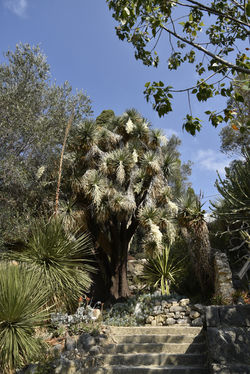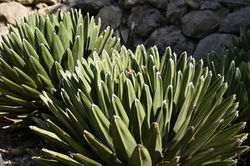LIGURIA
VENTIMIGLIA
HANBURY BOTANICAL GARDENS
BY ALESSANDRA VALENTINELLI
Today the Hanbury Gardens are not only of scientific interest and a feast for the eyes, but they also offer a unique insight into the history of botanical studies. The current collections are a reflection of the succession of the individual curators, the ties formed with botanical gardens around the world, and the thoughtfulness of the owners, which developed over the long years spent in La Mortola. For these reasons the different blooming calendars embrace the alternating of months and explain the succession of “cultural periods” relating to the acquisition of the collections.

The Hanbury Gardens first started as a nursery for the acclimation of exotic plants. The gardens still retain their original purpose amid its century old specimens that are an integral part of the plant collection: the Pinus canariensis, the Araucaria from Queensland, the Casimiroa and its edible fruits, were all imported between 1868 and 1872. These stand witness to the pharmacopoeia studies conducted by Sir Thomas's brother, the botanist Daniel Hanbury.
When taking a walk around the Palace, one actually walks through a living record of the voyages, the memories and the relationships the Hanbury weaved with all corners of the Earth: the pomegranate tree that lined the loggia, the Banksia that Sir Thomas brought back from China, the Samuela, a Mexican desert Yucca variety discovered in 1900 by William Trelease, and the Cupressus lusitanica donated by Gustave Thuret, the director of the Jardin des Plantes of Antibes in 1869. In 1912 this tree measured 16 metres in height and had a 1.7 metres circumference. It now tops 25 metres and has a diameter of 5 metres. The same can be said of the "Topia", the pergola that adorned Marquis Orengo’s gardens, side by side to where wisterias, clematis, bignonias and thunbergias, the Semele from the Canary Islands, the Homalocladium from the Solomon Islands, and the Vietnamese Tetrastigma thrive.
Behind the Palace lies the steeper part of the gardens. Here, one can find the most faithful blueprint of the project mapped out by Ludwig Winter according to Sir Thomas Hanbury’s wishes. One of the reasons was the building constraints of the irrigation system and the consolidation of walls made right after the purchase of the estate, in order to outfit the old terrace formations.
Walking eastbound one finds the succulent slope. Here the African aloes planted by Kurt Dinter are predominant. Later Alwin Berger populated it with many American cacti varieties. Three hundred and twenty five species of Aloe: the columnar A.principis, the creeping A.mitriformis, the lithe A.striatula, the pink blanketing of the Drosanthemum, and over one hundred varieties of agave and cacti, among which are the Yucca elephantipes and australis, the deep carmine colours of the Schotia brachypetala and the the Beaucarnea stricta and recurvata. Whereas, walking westbound one reaches the "Grande Route", that was designed by Winter and was also accessible by cars. The palm grove is visible upon arrival, but so are the rarest species personally handpicked by the Hanburys: the Musa paradisiacal maurelii and cavendishi banana trees, native to tropical Africa; the Brahea dulcis and armata palms trees; the Microcitrus, an Australian wild citrus variety; the Chiranthodendron pentadactylon discovered in the mid-nineteenth century in Guatemala; the Ginkgo biloba that back then could only be obtained from inland China; the Chicas revoluta and the Macrozamia, two family varieties that date back to the Mesozoic Era; the Saharan Ephedra altissima and the Chilean Quillaja saponaria evergreen.
The diverse variety of plants, which adapted differently to the local climate and that were planted in close proximity, resulted in a blooming season that lasted year round. This display is still visible today, with the turning of the seasons, and may be viewed at all times on the terraced slopes adjacent to the villa by simply letting the eye wander along the subtropical plants of the "Four Seasons Garden", which bloom from winter to late summer, or the “Japanese Garden” that harbours irises, daffodils and plum trees, or from the roses and peonies expanse, up to the pathway that heads to the villa, lined with the aromatic plants: sage, thyme, lavender and marjoram, and also the fragrant scent of wintersweet, of jasmine, honeysuckle and bitter orange trees.
South of the villa, next to the garden paths that originally lead to the Gardens and the “Vista Nuova”, the panoramic entrance inaugurated by Lady Dorothy Hanbury in 1920, is the Australian Forest with its Eucalyptus citriodora and sideroxylon, the Melaleuca preissiana and cuticularis, and the Sterculiaceae Brachychiton discolour.
The Meadow lies just across from the Iulia Augusta Roman Road, which cuts across the garden from east to west. In the letters written by Sir Thomas to his wife Katharine, he describes it as a wilderness, a scrubland expanse. At the very centre is the centuries-old olive grove that belonged to the Orengo Family. In the lower half of the Meadow one can see the displays brought about by Lady Dorothy, all commissioned after the disappearance of her in-laws. With the help of Sir Cecil Hanbury, husband and heir to the estate, of her father John Frederic Symons-Jeune, and of her brother Bertram Hanmer Bunbury Symons-Jeune, the former a landscape architect whilst the latter a nurseryman specialized in rock gardens, the Meadow is embellished by ancient cultivars: citrus shrubs and exotic fruits trees native to the valleys of Liguria.
Adjacent to the “Viale degli Ulivi” (the Olive Path), which leads to the coast, are lemons, grapefruit, tangerines, clementines and countless varieties of Citrus: citrons, myrtle-leaved oranges, bergamots and sweet and bitter oranges. On the eastern slope, one finds cultivations of South American and New Zealander fruit trees, Chinese quinces, peach and loquats, or Japanese medlars, local mountain ashes, hazelnuts, jujube and pistachio varieties. Finally, near the coastline, scattered among the pines, is the rockrose and the sage field. One can also admire the Acacia karroo with its large thorns and a young male tree of Olmediella betschleriana native of Mexico. The only other specimen of this tree present in the whole of the European continent is a female one. It can be found in the Naples Botanical Garden.
In 1960, following the aftermath of WWII and the destruction caused by the opposing French and German fronts, Dorothy sold the Gardens to the Italian government. The Italian government placed them under the historical building and landscape Protection Act. In 1983, the University of Genoa took charge of the estate and in the year 2000 it became a “Protected Marine Area”. Today with 2,500 taxa, a mixture of old and new plants, the Department of Botany also manages a Germplasm or Seed Bank for the conservation of endemic biodiversity, the latter being at risk in the Ligurian Alps. An on-going project is the Herbaria, established by the original gardeners and curators. This brings us full circle, linking the Hanburys’ dreams and hopes for a brighter future in today’s botanical studies and all researches to come.
 |  |  |
|---|---|---|
 |  |  |
 |  |  |
 |  |  |
 |  |  |
 |  |  |
 |  |  |
 |  |  |
 |  |  |
 |  |  |
 |  |  |
 |  |  |
 |  |









